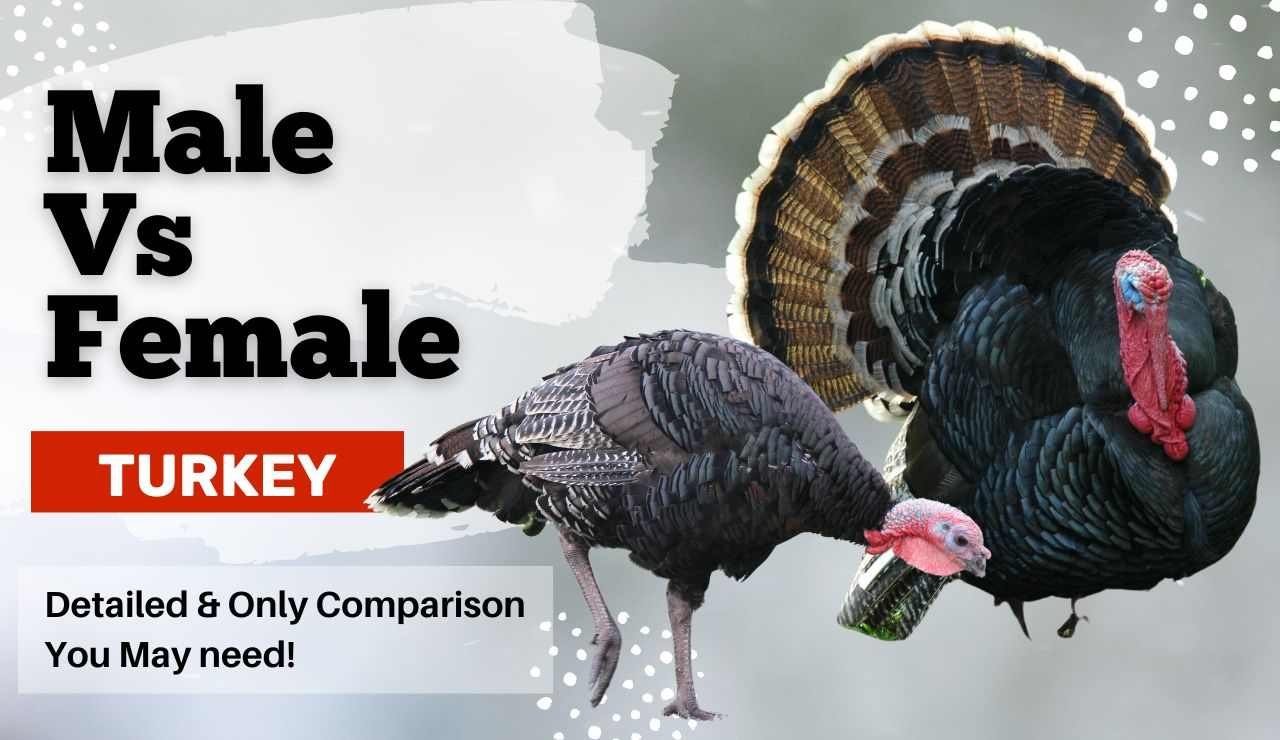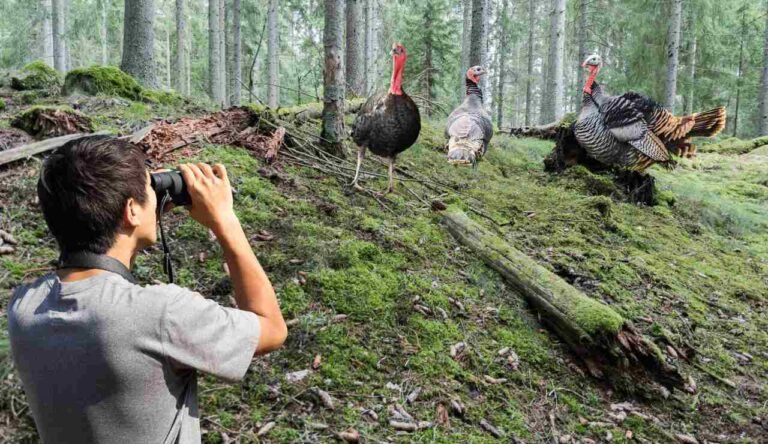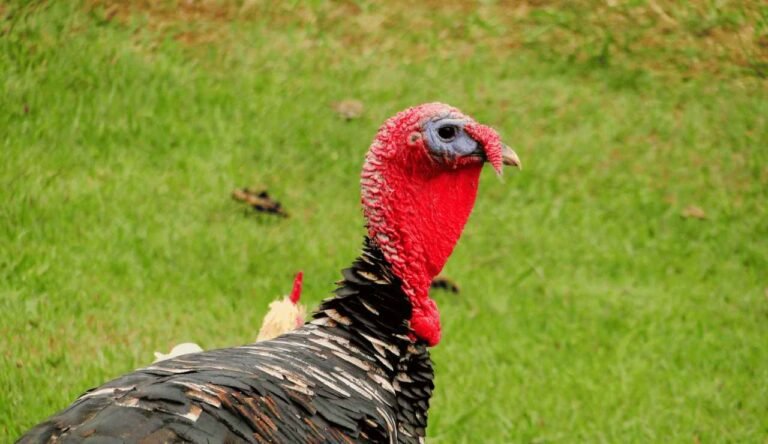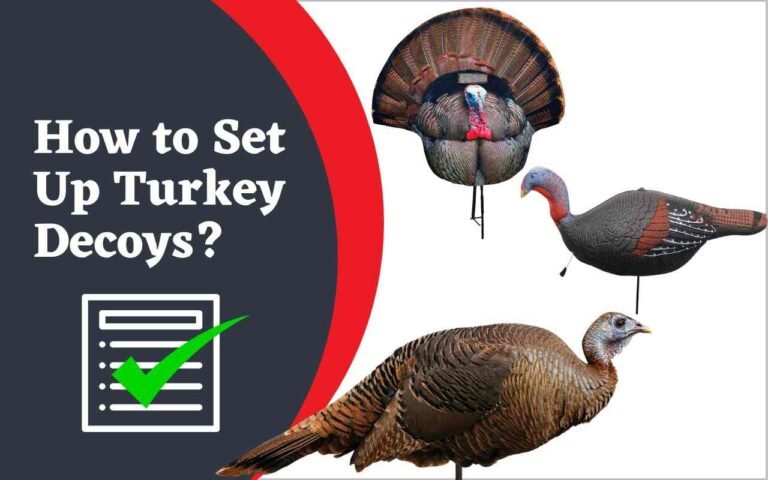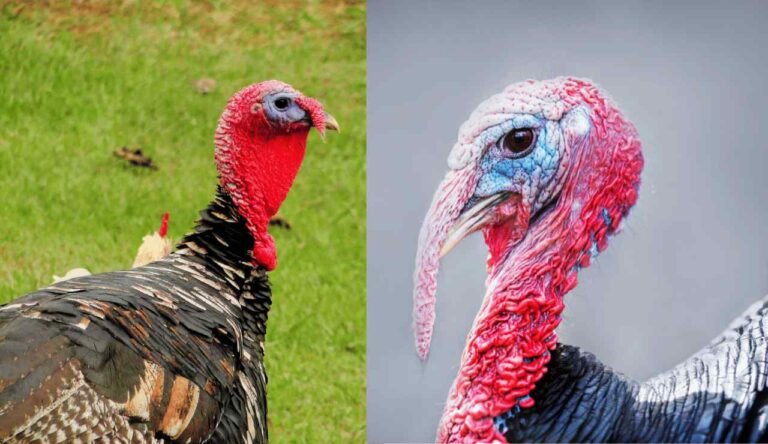Male Vs Female Turkey: The Ultimate Guide & Comparison
It should come as no surprise that turkey is a widely used kind of poultry meat in cuisines throughout the globe, given its nutritious qualities. Both male and female turkeys are used in industrial turkey farming, although they are reared separately. Due to their greater growth rates than their female counterparts, male turkeys are usually raised for their flesh. Male and female turkeys’ behavior, physical traits, and reproductive systems vary greatly. On this page, we’ll examine the differences between male and female turkeys and the characteristics that set them apart.
What distinguishes a male from a female turkey?
There are many physical traits to distinguish male and female turkeys. Males tend to be bigger than females and have more colorful feathers with iridescent tones of green, purple, and bronze. Females, on the other hand, have less vibrant feathers, with breast feathers that are rusty brown, white, or gray at the tips. Here are several methods for identifying male and female turkeys:
Size: Men are typically larger than women in terms of weight and length. Female domestic turkeys are around eighteen pounds and thirty-five inches long, while males weigh between 30 and 80 pounds and measure about forty-five inches. Wild female turkeys, sometimes known as hens, are between 30 and 37 inches long and weigh 5 to 12 pounds.
Vent opening: Checking the vent entrance, which is beneath the tail and in between the legs of a young turkey, is required for this technique. Male poults lift their legs, while female poults let their legs hang.
Snood and wattle: Male turkeys have bigger wattles, or the skin flap beneath their beak, as well as a snood, or the skin flap that hangs over their beak. Typically, male turkeys have longer snoods and more pronounced wattles.
Head and neck feathers: Male turkeys have more feathers on their heads and necks than females, and their color is iridescent, which is missing in females. The head and neck are smaller and less colorful in females.
Beard and spur: Only male turkeys have a beard and spurs. While spurs are found on the rear of the legs, the beard is a tuft of hair-like feathers that emerges from the breast. Tom turkeys have lengthy, up to 10-inch-long beards. Male turkeys have at least 1/2 in (1.3 cm) long spurs on their legs to fight other males during mating season, but females do not. The spurs of juvenile males are shorter than those of older males. Spurs are used by male turkeys to dominate other males during breeding.
Voice: Female turkeys may produce a range of noises, including clucking, cooing, purring, and hissing. Their voices are lower pitched than those of male turkeys.
It’s crucial to remember that these techniques are imperfect, and it may still be difficult to identify a turkey’s gender with absolute certainty.
Physical Differences
Size and weight differences between male and female turkey
| Characteristic | Male Turkey | Female Turkey |
|---|---|---|
| Average Weight | 8-25 kg | 2.7-6.8 kg |
| Average Height | 100-120 cm | 70-90 cm |
| Average Wingspan | 1.8-2.4 m | 1.2-1.5 m |
| Average Body Length | 120-150 cm | 90-100 cm |
Differences in coloration and feather patterns
| Characteristic | Male Turkey | Female Turkey |
|---|---|---|
| Head and Neck | Bright red or blue, with a fleshy wattle | Duller red, with smaller wattle |
| Breast and Body feathers | Black and iridescent | Lighter brown, with less iridescence |
| Wing and Tail feathers | Bronze and brown, with white markings | Brown and tan, with less white markings |
| Overall coloration and feathering | More colorful and bold | Duller and less bold |
Head and neck features comparison
| Characteristic | Male Turkey | Female Turkey |
|---|---|---|
| Head | Lumpy and irregular, with a fleshy wattle and snood | Smooth and streamlined, with a smaller wattle |
| Neck | Thick and muscular, with feathers sticking straight | Thin and pliable, with feathers draping to the side |
Behavioral Differences
Mating behaviors of male vs. female turkey
| Behavior | Male Turkey | Female Turkey |
|---|---|---|
| Courtship display | To entice females, male turkeys go on elaborate courting displays, including blowing up their feathers, fluttering their tails, and vocalizing. | Females do not participate in courting displays, although they may react to male displays. |
| Mating | During breeding season, males compete with other men for access to females by mating with a variety of females. | During breeding season, females may mate with numerous males and choose partners depending on the displays and behavior of the males. |
| Incubation of eggs | Males do not care for their parents or incubate eggs. | Females take care of their children and nurture eggs. |
Social Behaviors of Male vs. female turkey
| Behavior | Male Turkey | Female Turkey |
|---|---|---|
| Group behavior | Outside of mating season, males often form tiny bachelor flocks. | Females may create bigger flocks all year long. |
| Aggression | Males during breeding season may act aggressively against other males. | Over resources like food and breeding locations, females may act aggressively against other females. |
| Communication | To communicate with other male turkeys, males use a variety of vocalizations, such as gobbles, purrs, and clucks. | Female turkeys may communicate with one another using a variety of vocalizations and body language. |
Territorial behaviors comparison
| Behavior | Male Turkey | Female Turkey |
|---|---|---|
| Territory establishment | In order to attract females, males form territories during breeding season. | In order to nest and get food, females may develop territories. |
| Defense of territory | To avoid competing for mates, men protect their territory from other males. | When competing with other females for resources like nesting places, females may protect their territory. |
| Territorial marking | To create and protect their territory, males may scent mark. | Females may convey to other turkeys the limits of their territories via vocalizations. |
Baby Male Vs Female Turkey
- While infant female turkeys have flat vents, baby male turkeys have bumping vents.
- Turkeys have openings between their legs and under their tails, enabling them to breed.
- With one hand, gently hold the bird’s wings down while you lift it, then look between its legs to establish the bird’s sex.
- The young turkey is male if the vent resembles a hump more than a flat surface; otherwise, the poult is female.
- When you take up a male baby turkey, his legs tuck together, whereas a female bird leaves her legs hanging down.
- Male turkey poults tend to become more aggressive and territorial against other birds as they age.
- Pecking and fighting are a few typical aggressive turkey activities.
Health & Nutritional Differences
Nutritional requirements of male vs. female turkey
Due to biological variances, male and female turkeys have distinct nutritional requirements. Due to their bigger size and greater muscular mass, male turkeys need more protein than females do. Contrarily, female turkeys need extra calcium and phosphorus during the egg-laying season to produce eggshells.
| Nutritional Requirements | Male Turkey | Female Turkey |
|---|---|---|
| Protein intake | High | Lower |
| Calcium intake | Lower | High |
| Phosphorus intake | Lower | High |
Dietary differences between male and female turkey
Depending on their age and physiological stage, male and female turkeys have different food needs. For instance, during their growth period, male turkeys need a diet rich in protein (up to 28%) to promote the development of their muscles. In contrast, female turkeys need a diet rich in calcium and phosphorus (up to 1.0% and 0.45%, respectively) to encourage the production of eggshells. Both sexes need a balanced diet that includes the necessary vitamins, minerals, and amino acids for optimum development and health.
| Dietary Requirements | Male Turkey | Female Turkey |
|---|---|---|
| Protein | Up to 28% | Lower |
| Calcium | Lower | Up to 1.0% |
| Phosphorus | Lower | Up to 0.45% |
| Essential nutrients | Balanced | Balanced |
Health concerns comparison
The health problems that male and female turkeys are prone to include parasite infestations, bacterial infections, and respiratory illnesses. Due to their bigger size and weight, male turkeys are more prone to leg issues, including lameness and joint inflammation. However, female turkeys are more vulnerable to reproductive issues such as egg binding and prolapse during the egg-laying season.
| Health Concerns Comparison | Male Turkey | Female Turkey |
|---|---|---|
| Respiratory diseases | Susceptible | Susceptible |
| Bacterial infections | Susceptible | Susceptible |
| Parasitic infestations | Susceptible | Susceptible |
| Reproductive problems | Not applicable | Egg binding and prolapse |
| Leg problems | Lameness and inflammation | Less susceptible than male turkeys |
Economic Significance
Turkeys are raised primarily to produce meat, which gives them economic significance. The economic importance of male and female turkeys in meat production, breeding and genetics, market demand and price will be contrasted in this section.
Meat Production Comparison
The development and carcass yields of male and female turkeys vary, impacting the amount of flesh they produce.
| Parameter | Male Turkey | Female Turkey |
|---|---|---|
| Growth Rate | Faster | Slower |
| Carcass Yield | Higher | Lower |
| Dressing Percentage | 80-85% | 70-75% |
| Preferred for Meat Production | Yes | Yes |
Breeding and Genetics Comparison
The breeding and genetics of turkeys are crucial to their economic production. Turkey males and females have different breeding traits and genetic makeup.
| Parameter | Male Turkey | Female Turkey |
|---|---|---|
| Breeding Characteristics | Most commercial flocks of turkeys choose toms as their sires. | The main source of eggs for production and hatching is hens. |
| Genetics | Males have a ZZ sex chromosome. | Females have a ZW sex chromosome. |
Market Demand and Pricing Comparison
Several variables, including flavor, texture, and customer preferences, influence the demand for male and female turkeys. Both male and female turkeys are priced differently as a result.
| Parameter | Male Turkey | Female Turkey |
|---|---|---|
| Market Demand | Higher demand for male turkeys for their larger size and more flavorful meat. | Due to their smaller stature and more delicate flesh, female turkeys are in more demand throughout the Christmas season. |
| Pricing | Usually offered for less per pound than female turkeys. | Typically sold at a higher price per pound than male turkeys. |
Conclusion
In conclusion, toms, or male turkeys, are much bigger than female turkeys. Female domestic turkeys are around 35 inches long and weigh about 18 pounds, while male domestic turkeys may weigh anything from 30 to 80 pounds and measure about 45 inches. In addition, male turkeys differ from females in having longer snoods, bigger wattles, and sharper spurs. Compared to male turkeys, females also have legs that are smaller and shorter.
Frequently Asked Questions on Male Vs. Female
How can I tell the difference between a male and a female turkey?
There are many physical traits to distinguish male and female turkeys. Examining their size, vent opening, snood and wattle, head and neck feathers, beard and spur, and voice are a few methods to tell them apart. Females often have fewer colorful feathers and are smaller than males, who also tend to have more colorful feathers.
Which turkey is better for meat, male or female?
Commercial sales of turkeys include male and female birds, although toms, or male turkeys, are often bigger than hens. Tom turkeys often weigh above 18 pounds, whereas hen turkeys typically weigh around 14 pounds. In contrast to female turkeys, which have beards, male turkeys have spurs and a more angular skull. The turkey’s age also has a big impact on taste, even though the flesh of a female turkey is often more soft and tasty.
Can I keep male and female turkeys together?
Keeping male and female turkeys together is possible, but care should be taken to avoid conflict during the mating season. To protect the hens, it is advised to have one tom every 5–10 hens. To prevent the transmission of infections, hens and turkeys should not be housed together. To prevent problems with breeding, it’s critical to be able to tell male from female turkeys.
Do male and female turkeys make different sounds?
Turkeys’ calls vary between the sexes. Due to the varied sizes and forms of their vocal cords, male turkeys, also known as toms, have a deeper voice than female turkeys, also known as hens. Male turkeys gobble to attract a female during the spring by expanding their esophagus and expelling air via their lips. Other vocalizations by male turkeys range from a soft purr to a booming gobble. In addition to hissing as a warning to other turkeys, female turkeys also use clucking sounds to communicate with other birds, especially toms. However, based purely on their noises, turkeys might be challenging to gender-identify.
Can male turkeys lay eggs?
Only female turkeys or hens are capable of laying eggs. Hens may lay unfertilized eggs without a male present, but these eggs will not hatch into live young. Turkey egg production peaks in early May, with the primary egg-laying months being March and April. Hens produce one clutch of eggs each year, which may include four to seventeen eggs. Only when a male turkey or tom is present can fertilization take place, and fertilized eggs will eventually hatch.
What are the farming practices for male and female turkeys?
Due to industrialization, which makes it affordable to produce a sizable quantity of meat, turkey farming is widespread around the globe. Male and female turkeys are raised separately in commercial turkey farms for management reasons. Male turkeys weigh an average of 41 pounds compared to hens’ 17 pounds, making them bigger than females. Poults are sexed to regulate their nutrition and growing needs and to stop male turkeys from fighting, which may result in harm or death. Due to the size difference between male and female turkeys, artificial insemination is also frequently utilized to breed turkeys.
- Florida Turkey Season 2025-2026: Latest Hunting Dates, Licenses & Rules Available! - October 16, 2025
- Delaware Turkey Season 2025-2026: [Everything You Need to Know Dates, Regulations, Bags & More] - October 16, 2025
- Connecticut Turkey Season 2025-2026: [Dates, Regulations, Bag Limits & More] - October 16, 2025 ul>
